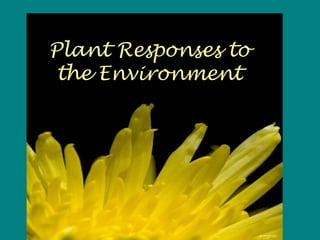Plant responses to the environment 1
•Télécharger en tant que PPT, PDF•
3 j'aime•2,763 vues
Signaler
Partager
Signaler
Partager

Recommandé
Recommandé
Contenu connexe
Tendances
Tendances (20)
Crop Physiology and Its importance in agriculture.pptx

Crop Physiology and Its importance in agriculture.pptx
Plant structure, growth, and reproduction by Campbell Biology 7th edition

Plant structure, growth, and reproduction by Campbell Biology 7th edition
En vedette
En vedette (20)
Similaire à Plant responses to the environment 1
Similaire à Plant responses to the environment 1 (20)
11. Reproductive phase: Plant growth and development.pptx

11. Reproductive phase: Plant growth and development.pptx
Plus de jdrinks
Plus de jdrinks (20)
Plant responses to the environment 1
- 1. Plant Responses to the Environment
- 2. Plant Tropisms •When you hear the word “tropism”, what do you think of?
- 3. Maybe it reminds you of the words “tropical island”
- 4. Or “Tropical rainforest ?”
- 5. Or maybe you’re just a tired student who is sick of hearing about plants and just wants a stinking answer?!?! I swear, if she makes me take notes on plants again, I will throw this book at the wall and run for the hills!
- 6. So here are the facts… • Plant tropisms – Plants respond to an environmental stimulus by growing in a particular direction – Growth in response to a stimulus is called a tropism
- 7. • Like a 7th-grader’s attitude, a tropism can be positive or negative I better hurry up and get this report finished..then I’ll have more time for math Forget that book problems! report, I’m going to IM my friends all night! POSITIVE NEGATIVE
- 8. • Light Tropism – When you place a houseplant so that it gets light from only one direction, such as a window, what happens? – You may have noticed that the plant will start bending towards the light
- 9. • This is known as phototropism
- 11. • Gravity Tropism – Plant growth also changes in response to the direction of gravity – This change is called gravitropism – If a plant is placed on its side or turned upside down, the shoot tips have a negative gravitropism (away from the center of the Earth) and the roots have a positive gravitropism (towards center of Earth).
- 12. This plant is on its side, and the shoots still grow upward!
- 13. Seasonal Changes • Plants living in regions with cold winters can detect changes in seasons because the days get shorter and nights get longer • The opposite happens when spring and summer approach • Plants respond to the change in the length of day
- 14. Length of Day – short-day plants flower when night length is long – long-day plants flower when night length is short
- 15. Seasons and Leaf Loss – Evergreen trees shed some of their leave year-round so that some leaves are always on the tree • leaves are often covered with a thick cuticle to protect leaves from cold and dry weather
- 16. – Deciduous trees lose all of their leaves around the same time each year (either cold or dry season) • loss of leaves helps plants survive low temperatures or long periods without rain
- 17. Seasons and Leaf Color – leaves of deciduous trees may change color before they are lost – as fall approaches, green chlorophyll breaks down and orange and yellow pigments are revealed – they’re usually hidden by the green chlorophyll, but they are always present